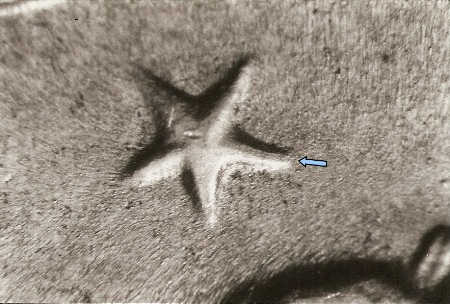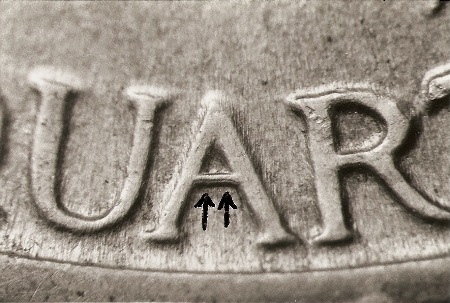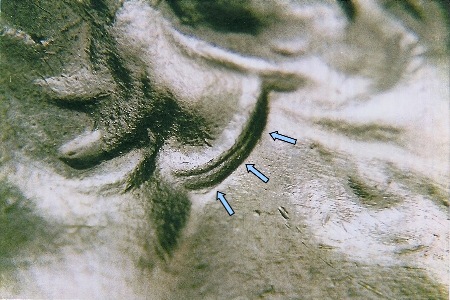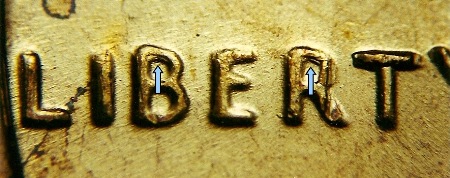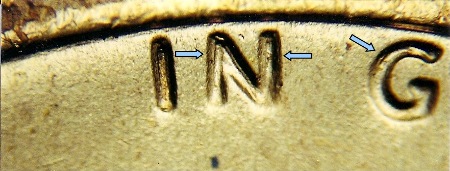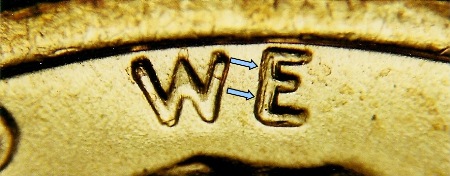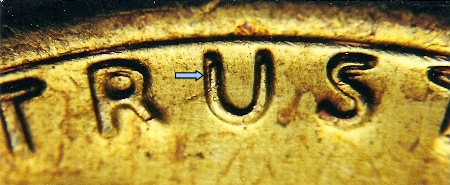


 |
 |
 |
 |
 |
 |
 |
 |
 |
 |
 |
 |
 |
 |
 |
 |
 |
 |
 |
 |
 |
 |
 |
 |
Let’s assume that a master hub has been produced and that master hub does not have any doubling. It is going to be used to produce a master die. As we have already seen on the How Dies Are Made page of this site, it is placed in a hubbing press above a die blank. The hubbing press is activated and squeezes the master hub into the die blank. Prior to the use of the single-squeeze hubbing presses, it was necessary to remove the partially completed master die from the hubbing press, anneal it, and then return it to the hubbing press to receive another impression. If there was any kind of misalignment between the image on the master hub and the image on the partially completed master die, a doubled image would appear on the master die. Over the years it has been found that different types of misalignments could occur between the image on the master hub and the image on the master die. The various types of misalignments produced unique characteristics to the doubling found on the hubs or dies. Each identifiable type of misalignment of images produced one the eight “classes” of doubled die varieties. At the end of this page there will be links to take you to separate pages explaining the various classes of doubled die doubling. When doubling did occur on a master die, the doubling was transferred to all working hubs produced by that master die. In turn the working hubs passed off that doubling to all of the working dies for that year. If a single master die was used for that year, then all of the coins of that denomination would have the exact same doubling in that year. Of course, if that doubling is on all of the coins of a denomination in a given year, then there is no extra value for coins with that doubling. They are far too common to have any additional value. In 1930 the reverse of the Standing Liberty quarters fell victim to a doubled master die. The three stars under the eagle show tripled left points. Some of the letters of QUARTER DOLLAR also show doubling.
The arrow points to close tripling on the point of one of the stars on the reverse of the 1930 quarters. All 1930 quarters produced that year show the same doubling and tripling.
Doubling can be seen on the horizontal crossbar of the A in QUARTER. This is also part of the master die doubling found on the reverse of all 1930 quarters. Do you have any 1944 Washington quarters? If so, check out the obverse where you should find strong doubling to the nostrils on the underside of the nose and also Washington’s earlobe. It too should show strong doubling. Typically this doubling would be considered significant, but unfortunately it was on the master die so all 1944 Washington quarters from all three Mints have the exact same doubling rendering it worthless.
Very nice doubling can be seen on Washington's ear on this 1944 quarter. Unfortunately, all 1944 quarters from all three mints show exactly the same doubling.
The underside of Washington's nose is actually tripled on the doubled master die that was produced. If not on a doubled master die this would be a very desirable doubled die variety, but as a doubled master die this can be found on all 1944 dated quarters. 1972 is well known for the major obverse doubled die and numerous lesser obverse doubled die varieties that were produced on the Lincoln cent that year. What some folks may not be aware of is that a doubled master die was also produced that year for the Lincoln cents. This is an unusual case where more than one master die was produced for a denomination in a given year. Shortly after the various obverse doubled die cent varieties were produced that year, the Lincoln cent master die for 1972 failed and a new one had to be produced. Clearly the Mint was having problems that year with the hubbing process as was evidenced by the many doubled die varieties produced. Those problems carried over to the second master die that was produced for the Lincoln cents that year. That second master die was produced with minor doubling. It is estimated that the doubled master die was created somewhere around April or May of 1972. All of the Lincoln cents struck by working dies that descended from the doubled master die show this minor doubling. The doubling can be seen on the letters of IN GOD WE TRUST, the letters of LIBERTY, and very slightly on the date. Since 60% to 70% of all Lincoln cents for 1972 show this doubling, it is far too common to have any value. This includes 1972 D-Mint, S-Mint, and proof coins produced that year. Newer doubled die collectors should be very careful if responding to ads for 1972 doubled die Lincoln cents. There are individuals out there trying to sell specimens of this doubled master die for premiums far in excess of what they should be. You should not be paying more than the normal numismatic value of a 1972 cent for 1972 cents with this master die doubling. Those trying to sell them to unsuspecting buyers advertise them as “genuine doubled dies” which they are. The ads are truthful in that respect, but they fail to tell you that it is a specimen of the doubled master die that can easily be found without paying a premium for it. Back when they were first listed they were assigned a listing number of 1972 1¢ MD-5-O-I+II. Those trying to sell them at a premium identify them as “5-O-I+II” but they leave off the master die indicator “MD.” If you are fairly new to doubled die collecting, don’t let yourself fall victim to these scams. If you would like to add a specimen of the doubled master die to your collection for educational purposes, go out and look for them yourself. Since the majority of 1972 cents show this doubling, you should easily find one for the cost of a “regular” 1972 Lincoln cent.
Arrows point to doubling on the B and R of LIBERTY on the doubled master die produced for the 1972 Lincoln cents.
The above photos show some of the doubling that can be found on the letters of IN GOD WE TRUST. It can be found on a high percentage of 1972 Lincoln cents from all three mints. | ||


